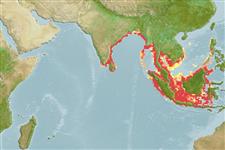Environment / Climate / Range
Ecology
Marine; freshwater; brackish; pelagic-neritic; amphidromous (Ref. 51243); depth range 0 - 50 m (Ref. 188). Tropical, preferred ?; 24°N - 9°S, 76°E - 121°E (Ref. 188)
Indo-Pacific: Indian Ocean (eastern coasts of India north to Calcutta), Indonesia (Jakarta, Java; also Kalimantan at Kotabaru, Takisung on southeastern coast and at Aluhaluh on Barito River). Records from the Arabian Sea and Thailand (Ref. 1632) need confirmation.
Size / Weight / Age
Maturity: Lm ? range ? - ? cm
Max length : 15.0 cm SL male/unsexed; (Ref. 188)
Dorsal
spines
(total): 0;
Anal
spines: 0;
Anal
soft rays: 38 - 46. Body moderately slender, belly with usually 19 to 21 - 8, total 27 to 29 scutes. Eye large, lower jaw projecting. Dorsal fin origin at about midpoint of body; anal fin origin under hind part of dorsal fin base. Vertical striae on scales not continuous, but with a distinct gap across center of scale. Swim bladder with two tubes passing back in the muscles on either side of haemal spines.
Occurs in coastal waters, but also enters rivers and tolerates water of low salinity. Feeds on planktonic crustaceans and fishes; also amphipods.
Life cycle and mating behavior
Maturity | Reproduction | Spawning | Eggs | Fecundity | Larvae
Whitehead, P.J.P., 1985. FAO Species Catalogue. Vol. 7. Clupeoid fishes of the world (suborder Clupeioidei). An annotated and illustrated catalogue of the herrings, sardines, pilchards, sprats, shads, anchovies and wolf-herrings. FAO Fish. Synop. 125(7/1):1-303. Rome: FAO. (Ref. 188)
IUCN Red List Status (Ref. 115185)
CITES (Ref. 94142)
Not Evaluated
Threat to humans
Harmless
Human uses
Fisheries: minor commercial
More information
Common namesSynonymsMetabolismPredatorsEcotoxicologyReproductionMaturitySpawningFecundityEggsEgg development
ReferencesAquacultureAquaculture profileStrainsGeneticsAllele frequenciesHeritabilityDiseasesProcessingMass conversion
Tools
Special reports
Download XML
Internet sources
